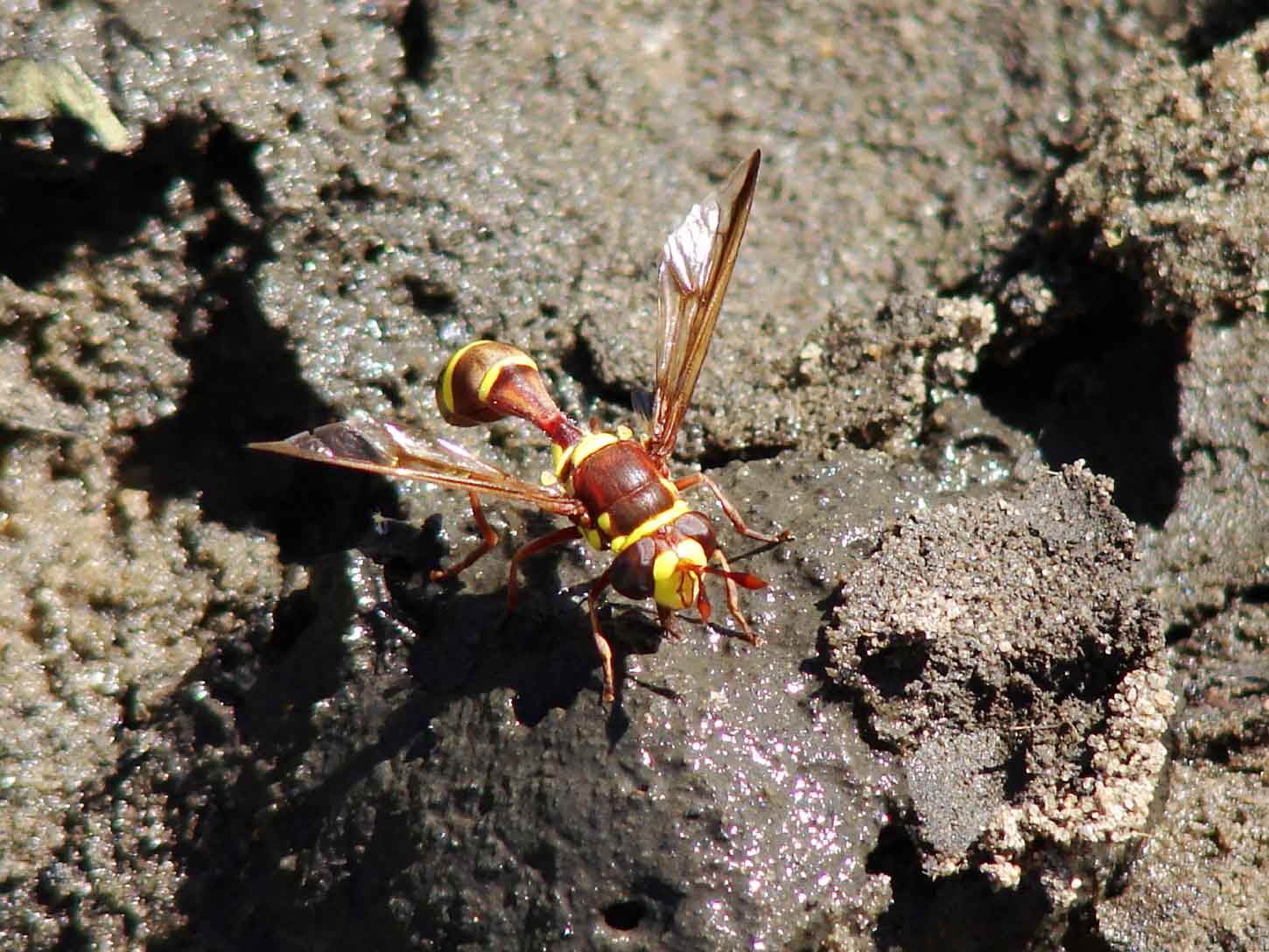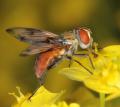Diptera.info :: Family forums :: Syrphidae
Who is here? 1 guest(s)
|
Cerioidini tribe (2)
|
|
| pierred |
Posted on 18-09-2013 07:45
|
|
Member Location: Paris (France) Posts: 1482 Joined: 21.04.05 |
Hi, This time, from Senegal:  OCIS : Sénégal : Nianing : : 15/12/2008 Altitude : NR - Taille : 20 mm Réf. : 40945  OCIS : Sénégal : Nianing : : 15/12/2008 Altitude : NR - Taille : 20 mm Réf. : 40946 In the same way, we concluded to the Cerioidini tribe. Does some of you have a more precise idea ? Thanks in advance. Pierre Duhem |
|
|
|
| Fred Fly |
Posted on 18-09-2013 09:07
|
|
Member Location: Germany Posts: 396 Joined: 19.07.11 |
It is belonging to Cerioidini and it should be Ceriana as well. |
|
|
|
| Valentin Nidergas |
Posted on 18-09-2013 21:51
|
|
Member Location: Savoie, France Posts: 79 Joined: 17.05.13 |
Thank you Piet Nord, but do you know how much genera there is in this tribe ? For example, I'm not agree to say Sphiximorpha is only a sub-genus of Ceriana... it's completely absurd because the morphology of antennas are completely differents between Sphiximorpha and Ceriana... |
|
|
|
| AaronS |
Posted on 30-10-2018 04:52
|
|
Member Location: California Posts: 13 Joined: 27.10.18 |
A beautiful cerioidine syrphid! As detailed below, this appears to be Monoceromyia gambiana or, equivalently, Ceriana (Monoceromyia) gambiana...depending on whether one adopts the "genus" or "subgenus" approach to cerioidine nomenclature. [Note: There are currently two nomenclatural schemes in use for the traditional groupings within the tribe Cerioidini of family Syrphidae. Unfortunately, this results in much confusion in the interpretation of (binomial) names among those not familiar with the situation. For more on this, see the last five paragraphs of my (long!) iNaturalist comment here...or the remarks beginning at the 4th paragraph of my (again long) comment under this Flickr post of Sphiximorpha roederi.] Regarding the two photos here, notice that 1) the frontal prominence is long; and 2) R4+5 lacks a spur vein, and the abdomen is petiolate (i.e. 2nd segment is long and distinctly narrowed)...which indicates (sub)genus Monoceromyia. [Note: The two links in the preceding sentence refer to an illustrated key for Nearctic taxa...nevertheless, the same conclusion of Monoceromyia here results from using the key to Afrotropical ceriodines at the bottom of the 2nd page of Thompson(2013).] A useful resource for info on the Afrotropical syrphid fauna is the AFROCATALOG PDF here, which is a 2010 manuscript for a yet unpublished work by Dirickx, de Meyre, Ssymank, & Thompson. There are also associated PDF's for a syrphid AFROGENERA key and a syrphid AFROBIBLIOGRAPHY. And you can check that, as noted above, the syrphid in this post again goes to Monoceromyia in the AFROGENERA key. The tribe Cerioidini appears on pages 91-98 of the AFROCATALOG PDF. Note that Polybiomyia is absent from catalog (though there is one Afrotropical species in Pseudopolybiomyia per Thompson(2015), which I *think* may correspond to Ceriana (Sphiximorpha) divisa in the AFROCATALOG PDF...but it won't matter for the discussion here). Since Polybiomyia does not come into play here, the syrphid in your photos goes, yet again, to Monoceromyia using the key on page 161 of Steenis et al (2016)...due to the long frontal prominence and petiolate abdomen. So we have firm support for placing this in genus Monoceromyia (or subgenus, for those who prefer that approach). As for species, if you go through the geographic range info for each entry under Monoceromyia on pages 92-96 of the AFROCATALOG PDF, you'll find that the only species ranging in the vicinity of Senegal are M. gambiana and M. hopei. These two species were described in Saunders(1845) on page 65 here and page 67 here, respectively...and also illustrated in dorsal view in Fig. 4 and Fig. 6, respectively, of his Plate IV here. Note that the description of Ceria gambiana is in excellent agreement with the individual photographed here (except the eyes here are reddish rather than black). However, Ceria hopei differs in having the hind abdominal tergites black and the hind femora uniformly brown (i.e. lacking the yellow basal bands described and figured for gambiana and evident in both photos). For further reinforcement of this ID, consider the key in Curran(1938)...which adopted the view that all species of the tribe Cerioidini comprise a single genus under the name Cerioides. For the two photos here, the keying sequence in Curran(1938) is: 1. Wings "differently colored" (i.e. not with 3 distinct brown spots along the costa, as in divisa).............2 2. Antennae situated on a pedicel (also called an "antennifer" or "frontal prominence" by other authors)......4 4. Scutellum yellow......................5 5. Pleura with yellow markings......7 7. Face with one or more black or brownish vitta.....8 8. Pleura with a yellow stripe..........9 ...and from there, since the remaining facial vitta characters of the key are not clearly discernible...the resulting candidates are pulchra, gambiana, and hopei. But as with hopei, according to the original 1913 description of Cerioides pulchra by Hevré-Bazin, the distal tergites of pulchra are described as being black (see last sentence of 3rd paragraph from the bottom on page 92 of Hevré-Bazin(1913)). Thus we again arrive at Cerioides gambiana = Monoceromyia gambiana = Ceriana (Monoceromyia) gambiana. PS: For those who read German, here's a link to Loew's 1853 comments on Ceria gambiana. Loew's comments on Ceria hopei are on the preceding page therein. If anyone does read this and finds interesting info for the ID here, pro or con, please share your thoughts (unfortunately, I have no reading comprehension of German). Edited by AaronS on 15-05-2021 03:00 |
|
|
|
| AaronS |
Posted on 09-07-2019 21:32
|
|
Member Location: California Posts: 13 Joined: 27.10.18 |
Recently, I ran into more of Pierre D's photos of this specimen (at this link). And one photo there provides a clear view of the face...and thus removes the ambiguity near the end of the keying process using Curran(1938) as presented in my comment above. Here's the photo:  ...and continuing with the keying sequence given in my comment above...starting from where the choice was previously unclear...we have: 9. Face with one or two vittae........10 10. Face with two brown vittae which meet above and below......gambiana Saunders So the ID of Monoceromyia gambiana seems unambiguous now. Edited by AaronS on 09-07-2019 21:37 |
|
|
|
| AaronS |
Posted on 09-07-2019 22:14
|
|
Member Location: California Posts: 13 Joined: 27.10.18 |
Valentin Nidergas wrote: Thank you Piet Nord, but do you know how much genera there is in this tribe ? For example, I'm not agree to say Sphiximorpha is only a sub-genus of Ceriana... it's completely absurd because the morphology of antennas are completely differents between Sphiximorpha and Ceriana... Valentin, I appreciate your point about the conspicuous differences between the antennae in Sphiximorpha and Ceriana. There are also large differences in the constriction & elongation of the basal portion of the abdomen between Monoceromyia and Ceriana. To answer your question: There are presently 4 main sub-taxa (i.e. with a large number of species) in the tribe Cerioidini: Ceriana, Sphiximorpha, Monoceromyia and Polybiomyia (as well as some other subtaxa with only one or two+ species). But there are (at least) two different opinions among those who study the tribe as to whether it's best to treat those sub-taxa as genera or subgenera...and, unfortunately, that causes a lot of confusion for many people. Note that those who follow the "subgenus viewpoint" treat Ceriana as the single genus in the tribe Cerioidini. But that genus includes the nominate subgenus of the same name, Ceriana, as well as the other 3 subtaxa above as subgenera. So from the "subgenus point of view" both subgenus Ceriana (sensu stricto) and subgenus Sphiximorpha could still be regarded as very distinct from one another...the only difference is that the distinction is now regarded as one at the rank of subgenera rather than genera ;-) In my opinion, simply changing the rank at which you place the subtaxa here is mostly an artificial formality that really doesn't improve understanding of the inter-relationships of the taxa, but does introduce a lot of confusion...especially when adherents of the subgenera point of view use a binomial like "Ceriana gambiana" instead of the trinomial Ceriana (Monoceromyia) gambiana. If you're interested in more details on this topic then ... as stated in my initial comment above ... see the last five paragraphs of my (long!) iNaturalist comment here...or the remarks beginning at the 4th paragraph of my (again long) comment under this Flickr post of Sphiximorpha roederi." Edited by AaronS on 24-04-2020 19:29 |
|
|
|
| AaronS |
Posted on 09-07-2019 22:28
|
|
Member Location: California Posts: 13 Joined: 27.10.18 |
pierred wrote: Hi, Does some of you have a more precise idea ? Thanks in advance. Yes! This appears to be Monoceromyia gambiana (Saunders) 1845...per my comments above in this thread ;-) [Guess this is a somewhat old thread...which perhaps accounts for the lack of recent discussion, other than my detailed comments on the ID. So I'm messaging you Pierre in the hope that the info reaches you.] Edited by AaronS on 24-04-2020 19:30 |
|
|
|
| pierred |
Posted on 28-07-2021 06:41
|
|
Member Location: Paris (France) Posts: 1482 Joined: 21.04.05 |
Sorry for not answering. Thanks a lot for the argumented demonstration. Pierre Duhem |
|
|
|
| Jump to Forum: |













